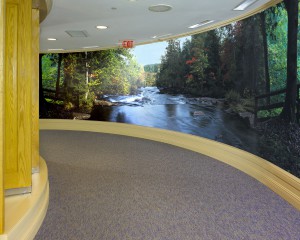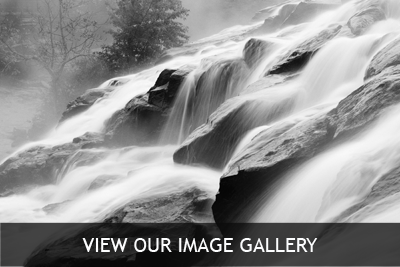
Supergraphic Curved Wall Mural 60’x 8′
Printing methods and substrates
In general, there are three printing processes used to create supergraphics: inkjet, digital photographic, and analog. Although digital photographic methods yield the highest image quality, the end result is costlier and less durable than other methods. Analog methods, such as screen printing, tend to be more durable, but the cost varies greatly based on the quantity of printed materials to be produced.
The most commonly used process today is UV-cured inkjet printing. This method has the advantage of higher quality image capabilities with lower cost and improved durability. Most of the off-gassing occurs during the printing process, so the downtime after installation in an existing facility is reduced. Off-gassing will occur with all printing methods, but certain materials, such as resin, tend to emit stronger odors for several weeks. For a quick-turnover project, this should be considered, and materials for projects in occupied spaces should be kept off-site until the off-gassing has completed.
It’s also important to consider that healthcare environments tend to experience abuse from cart traffic and aggressive cleaning protocols. Designers should seek the owner’s input about locating certain substrates in challenging locations and test surfaces with environmental services staff. Many custom-printed substrates, like vinyl wallcovering and resin, will withstand bleach cleaning, but it’s important to know in advance. Another option is to sandwich an image between two layers of a more durable material, such as glass, if cleaning chemicals are a concern.
Answering durability concerns, several manufacturers offer custom-printed impact wall panels for a reasonable cost. Paired with impact-resistant gypsum board, these materials provide an attractive alternative to traditional wall protection and allow the design team to express the design vision without compromising performance.
Vinyl or coated wallcovering and resin can withstand intermediate wear and tear. For example, wallcovering may be used above the “impact zone” of corridors if the manufacturer offers a topcoat for increased durability. For the most challenging environments, including exterior applications, ceramic-coated steel offers a superior performance option, but the print process prevents certain colors from being as true as others, which should be factored in when selecting an image.
All printed substrates will have seams that vary based on the size limitation of the manufacturer. In some cases (wallcovering and wall protection), the seams will be almost invisible and have little impact on the design. For other substrates (metal panels, wood, or resin), the seams will be more prominent and should be identified and reviewed on shop drawings.
Selecting the art
Finding the right image is just as critical as specifying an appropriate substrate. Some of the most common methods of procuring graphics include:
- Choose from a manufacturer’s library of images. Many companies have an extensive archive of photos available that are essentially free, so the only cost is for the substrate and installation. This may be the best option for projects with smaller budgets, but the images should be reviewed before specifying a particular manufacturer’s substrate.
- Purchase the rights to an existing image from a photographer or artist. Art consultants are a good resource for identifying existing photographs and artwork appropriate for large-scale printing. Even without an art consultant, designers can find online sources for large-scale images. Most websites will indicate a maximum print size, but for very large images, this size should be verified prior to purchase.
- Commission an artist or photographer to create an image specific to the installation. Sometimes an inexpensive alternative to purchasing an existing photo is to commission a photographer to take images of a desired landscape. Knowing the size of the installation and locations of interruptions (such as doors and windows) allows the artist to create a tailored image.
- Hire a graphic designer. A graphic designer can be a wonderful asset to a project using supergraphics. Some health systems have a branding guide that a graphic designer may use to plan custom design elements for a project.
Whichever option is used to create or procure the image, it’s important to consider the lighting that will be in the space. For example, side-lit graphics, such as an installation perpendicular to a large window, will expose imperfections in the substrate or wall behind it. Images with a medium or dark color and a busy pattern or image will be more forgiving on a less-than-perfect wall surface.
Watch for Part 3 coming in January 2019.
For a pdf version click here:Photos for Healing Newsletter #127- Nov. ’18


